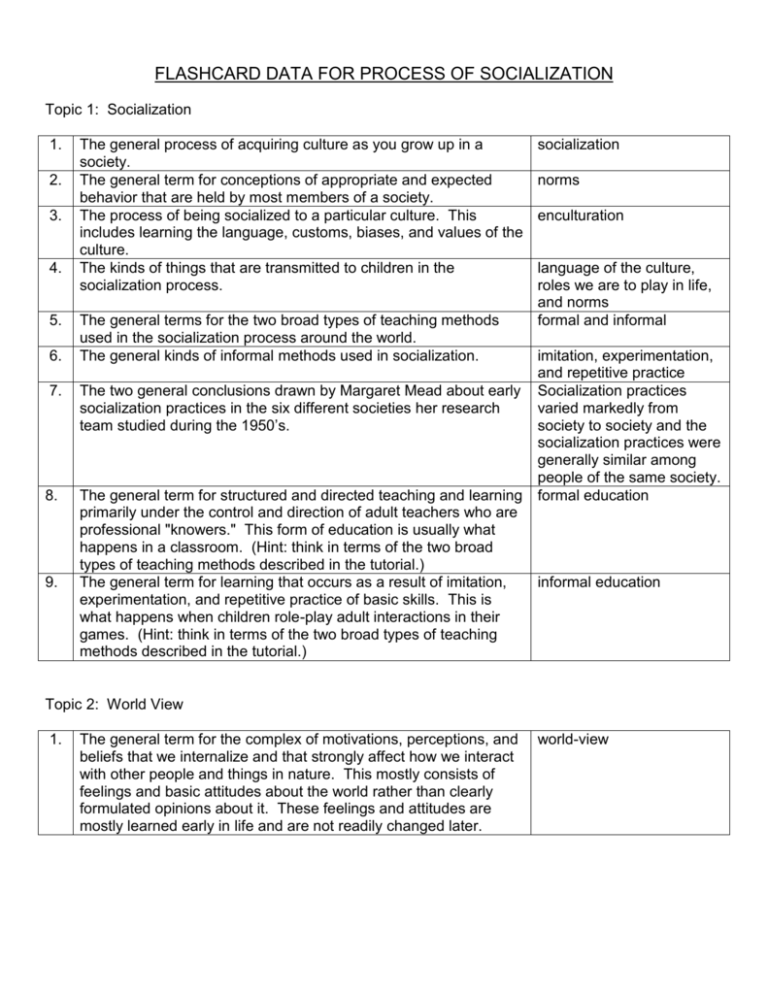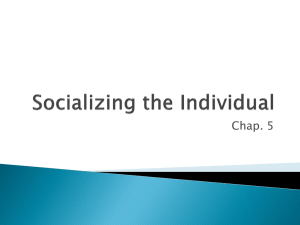
FLASHCARD DATA FOR PROCESS OF SOCIALIZATION
Topic 1: Socialization
1.
2.
3.
4.
5.
6.
The general process of acquiring culture as you grow up in a
society.
The general term for conceptions of appropriate and expected
behavior that are held by most members of a society.
The process of being socialized to a particular culture. This
includes learning the language, customs, biases, and values of the
culture.
The kinds of things that are transmitted to children in the
socialization process.
The general terms for the two broad types of teaching methods
used in the socialization process around the world.
The general kinds of informal methods used in socialization.
7.
The two general conclusions drawn by Margaret Mead about early
socialization practices in the six different societies her research
team studied during the 1950’s.
8.
The general term for structured and directed teaching and learning
primarily under the control and direction of adult teachers who are
professional "knowers." This form of education is usually what
happens in a classroom. (Hint: think in terms of the two broad
types of teaching methods described in the tutorial.)
The general term for learning that occurs as a result of imitation,
experimentation, and repetitive practice of basic skills. This is
what happens when children role-play adult interactions in their
games. (Hint: think in terms of the two broad types of teaching
methods described in the tutorial.)
9.
socialization
norms
enculturation
language of the culture,
roles we are to play in life,
and norms
formal and informal
imitation, experimentation,
and repetitive practice
Socialization practices
varied markedly from
society to society and the
socialization practices were
generally similar among
people of the same society.
formal education
informal education
Topic 2: World View
1.
The general term for the complex of motivations, perceptions, and
beliefs that we internalize and that strongly affect how we interact
with other people and things in nature. This mostly consists of
feelings and basic attitudes about the world rather than clearly
formulated opinions about it. These feelings and attitudes are
mostly learned early in life and are not readily changed later.
world-view
2.
3.
4.
5.
6.
7.
The kind of world-view in which people believe that humans are
not separate from nature and the supernatural. Living creatures
and non-living objects in nature as well as supernatural beings are
thought to be human-like in their motivations, feelings, and
interactions. They all are perceived as "thous" rather than "its."
(Hint: this kind of world-view was first described by Robert
Redfield in the early 1950’s.)
The kind of world-view in which people have an emotional
detachment between themselves and the realms of nature and the
supernatural. Animals, trees, rocks and other things in nature are
"its" rather than "thous" and do not have human personalities.
(Hint: this kind of world-view was first described by Robert
Redfield in the early 1950’s.)
The kind of world-view that is the most common in the Western
World today. (Hint: this kind of world-view was first described by
Robert Redfield in the early 1950’s.)
The kind of world-view in which people can more easily exploit
nature ruthlessly with little care for its well being because it only
consists of things rather than human-like beings. (Hint: this kind of
world-view was first described by Robert Redfield in the early
1950’s.)
A god who established the order of the universe in the distant past
and is now remote from earthly activities and concerns.
The general term for fundamental values that provide the basis for
social behavior in society. They are what people believe is
desirable or offensive, appropriate or inappropriate, and correct or
incorrect.
indigenous world-view
(Redfield called it a
“mythological world-view”)
metropolitan world-view
(Redfield called it a
“civilized world-view”)
metropolitan world-view
metropolitan world-view
otiose deity (or god)
core values
Topic 3: Personality Development
1.
2.
3.
4.
5.
Ruth Benedict’s belief about what is responsible for personality
differences between people, especially from different parts of the
world. (Hint: think in terms of learning and heredity.)
Margaret Mead’s belief about what causes masculine personality
traits in men and feminine ones in women. (Hint: think in terms of
learning and heredity.)
The region of the world where Margaret Mead carried out most of
her research into the causes of masculine and feminine
personality traits.
The general term for the most common personality type within a
society.
The modal personality that has a strong emphasis on doing things
the same way that they have always been done. (Hint: this type of
personality was identified by David Riesman in the early 1950's.)
only learning (Few
anthropologists would
agree today.)
only learning (Few
anthropologists would
agree today.)
South Pacific (Polynesia
and Melanesia)
modal personality
tradition-oriented
personality
6.
7.
8.
9.
The modal personality that is guilt oriented. The behavior of
individuals with this sort of personality are strongly controlled by
their conscience. As a result, there is little need for police to make
sure that they obey the law. These individuals monitor
themselves. (Hint: this type of personality was identified by David
Riesman in the early 1950's.)
A distinct culturally specific personality pattern acquired during the
process of being enculturated. This idea that personality is almost
entirely learned rather than genetically inherited is no longer
widely believed in anthropology and psychology. However, it was
a common view during the first half of the 20th century as a result
of the work of Ruth Benedict and others.
The modal personality that is shame oriented. People with this
type of personality have ambiguous feelings about right and
wrong. When they deviate from a societal norm, they usually don't
feel guilty. However, if they are caught in the act or exposed
publicly, they are likely to feel shame. (Hint: this type of
personality was identified by David Riesman in the early 1950's.)
An individual’s entire complex of mental characteristics that makes
him or her unique from other people. It includes all of the patterns
of thought, emotions, and other mental traits that cause us to do
and say things in particular ways.
inner-directed personality
national personality type (or
ethos)
other-directed personality
personality
Topic 4: Rites of Passage
1.
2.
3.
4.
5.
The general term for ritual ceremonies intended to mark the
transition from one phase of life to another.
The things that baptisms, bar mitzvahs and confirmations, school
graduation ceremonies, weddings, retirement parties, and funerals
have in common.
The medical term for removing all or part of the foreskin of the
penis with a knife. In some cultures, this surgery is part of a rite of
passage marking the transition from childhood to adulthood for
boys.
The medical term for cutting off all or part of the clitoris and
sometime all or part of the labia. In some African and Middle
Eastern cultures, this surgery is done as part of a rite of passage
marking the transition from childhood to adulthood for girls.
The medical term for cutting into the side of the penis or making a
hole entirely through it. In some cultures, this surgery is done as
part of a rite of passage marking the transition from childhood to
adulthood for boys.
Copyright © 2004 by Dennis O'Neil. All rights reserved.
rites of passage
As rites of passage, they
help the individuals making
the transition, as well their
relatives and friends, pass
through an emotionally
charged, tense time. They
also reinforce the dominant
values of the culture.
circumcision
clitoridectomy
subincision










